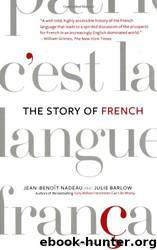The Story of French by Jean-Benoit Nadeau & Julie Barlow

Author:Jean-Benoit Nadeau & Julie Barlow [Nadeau, Jean-Benoit & Barlow, Julie]
Language: eng
Format: epub
ISBN: 9780307370495
Google: liZwswxx7TcC
Amazon: 0312341849
Publisher: Knopf Canada
Published: 2008-01-08T00:00:00+00:00
The source of France’s early mass appeal is very little documented. One of the rare books on the topic is Harvey Levenstein’s Seductive Journey, which recounts the history of American tourism in France from Jefferson to the Depression. As Levenstein explains, tourism in eighteenth-century Paris consisted mostly of small-scale travel for personal cultivation. It became increasingly recreational over the next century as the number of travellers grew. The development of steam power enabled people to get to France by land and by sea faster than ever before. As many as a quarter of a million Americans visited the country each year before the First World War, and the number of English and German visitors was much larger.
French was still the language of high-level politics and diplomacy in Europe, and this status, unchallenged until 1919, inspired considerable interest in France. But the nation was also considered a window to the future. The thirst for novelty and progress attracted unprecedented numbers of visitors to the four world’s fairs that France hosted in the nineteenth century. Between the fair of 1855 and that of 1867, attendance tripled from five million to fifteen million people. In 1889 it more than doubled to thirty-two million, and in 1900 it reached fifty million—considered a good turnout for international exhibitions even today.
The Anglo-American elites, couldn’t get enough of France, to which they began travelling en masse. By the 1880s the community of American and British expatriates was big enough to support Paris’s first English-language paper, the Paris Herald, created in 1887. And Paris’s influence shone as far as the American West, where people went to saloons (a corruption of salon) and enjoyed lively French operettas by the likes of Offenbach—and the French cancan.
The reasons for this interest in Paris were complex. For a long time Paris had been a mandatory stop on the grand tour, as the British called their cultural pilgrimages across Europe (the source of the term tourism). Nineteenth-century developments in arts, tastes, science and industry made Paris even more tantalizing. French taste in food and design set the standard for the world’s elite. Luxury items from the realms of fashion, perfume, wine and cuisine, already a French forte, acquired even more renown. Demand for these goods led an ambitious French merchant, Aristide Boucicaut, to buy the Paris store Au Bon Marché in 1852 and turn it into the first of the grands magasins (department stores), an idea that soon made its way abroad, notably to New York City.
Everyone looked towards France for the latest developments in everything. To keep the public informed and to transmit information to the capitals of Europe, a translator, Charles Émile Havas, created Agence Havas, the world’s first news agency, in 1841; one of his employees, Julius Reuters, started his own telegraph wire service in London in 1851. A Russian Jewish refugee in Paris, Eliezer Ben Yehuda, was so impressed with the French daily Figaro that he decided to recreate and modernize the Hebrew language so it could be used for modern communications (more on this in Chapter 17).
Download
This site does not store any files on its server. We only index and link to content provided by other sites. Please contact the content providers to delete copyright contents if any and email us, we'll remove relevant links or contents immediately.
Cecilia; Or, Memoirs of an Heiress — Volume 1 by Fanny Burney(32434)
Cecilia; Or, Memoirs of an Heiress — Volume 2 by Fanny Burney(31869)
Cecilia; Or, Memoirs of an Heiress — Volume 3 by Fanny Burney(31852)
The Lost Art of Listening by Michael P. Nichols(7403)
Asking the Right Questions: A Guide to Critical Thinking by M. Neil Browne & Stuart M. Keeley(5631)
We Need to Talk by Celeste Headlee(5542)
On Writing A Memoir of the Craft by Stephen King(4863)
Dialogue by Robert McKee(4321)
Pre-Suasion: A Revolutionary Way to Influence and Persuade by Robert Cialdini(4144)
I Have Something to Say: Mastering the Art of Public Speaking in an Age of Disconnection by John Bowe(3839)
Elements of Style 2017 by Richard De A'Morelli(3306)
The Book of Human Emotions by Tiffany Watt Smith(3237)
Fluent Forever: How to Learn Any Language Fast and Never Forget It by Gabriel Wyner(3025)
Name Book, The: Over 10,000 Names--Their Meanings, Origins, and Spiritual Significance by Astoria Dorothy(2938)
Good Humor, Bad Taste: A Sociology of the Joke by Kuipers Giselinde(2903)
Why I Write by George Orwell(2874)
The Art Of Deception by Kevin Mitnick(2735)
The Grammaring Guide to English Grammar with Exercises by Péter Simon(2706)
Ancient Worlds by Michael Scott(2622)
